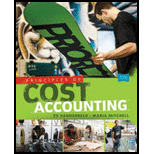
Review Problem for Chapters 1 and 2
UltraLift Corp. manufactures chain hoists. The raw materials inventories on hand on October 1 were as follows:

The balances in the ledger accounts on October 1 were as follows:

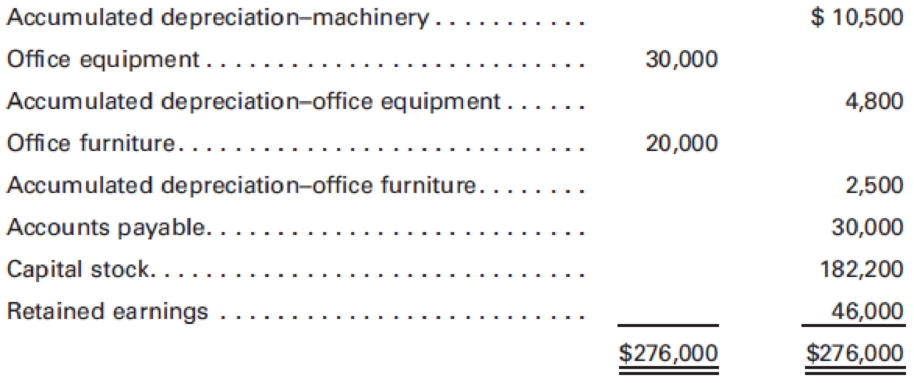
Transactions during October were as follows:
- a. Payroll recorded during the month: direct labor, $28,000; indirect labor, $4,800.
- b. Indirect materials purchased for cash, $1,000.
- c. Materials purchased on account: chain–4,000 lb, $8,800; pulleys–2,000 sets, $10,200; steel plates–5,000 units, $3,000.
- d. Sales on account for the month, $126,375.
- e.
Accounts receivable collected, $72,500. - f. Materials used during October (FIFO costing): chain–14,000 lb; pulleys–4,400 sets; bolts and taps–4,000 lb; steel plates–3,800 units.
- g. Payroll paid, $32,800.
- h. Indirect materials issued to production in October, $650.
- i. Factory heat, light, and power costs for October, $3,000 (not yet paid).
- j. Office salaries paid, $6,000.
- k. Advertising paid, $2,000.
- l. Accounts payable paid, $33,750.
- m. Expired insurance–on office equipment, $100; on factory machinery, $300.
- n. Factory rent paid, $2,000.
- o.
Depreciation on office equipment, $400; on office furniture, $180; on machinery, $1,200. - p. Factory
overhead charged to jobs, $11,950. - q. Work in Process, October 31, $31,000. (Hint: The difference between the sum of the beginning balance in Work in Process plus the total charges to it during the period less the ending balance in Work in Process represents the cost of the goods completed during the period.)
- r. Cost of goods sold during the month, $84,250.
Required:
- 1. Set up T-accounts and enter the balances as of October 1.
- 2. Prepare
journal entries to record each of the previous transactions. - 3.
Post the journal entries to the accounts, setting up any new ledger accounts necessary. Only controlling accounts are to be maintained; however, show the calculation for the cost of materials used. - 4. Prepare a statement of cost of goods manufactured for October.
- 5. Prepare an income statement.
- 6. Prepare a
balance sheet showing the classifications of current assets, plant and equipment, current liabilities, and stockholders’ equity.
1 and 3
Post the journal entries to T- account.
Explanation of Solution
Posting of transactions: The process of transferring the journalized transactions into the accounts of the ledger is known as posting the transactions.
T-account: The condensed form of a ledger is referred to as T-account. The left-hand side of this account is known as debit, and the right hand side is known as credit.
Post the entries to T-account.
Prepare T-account for Cash.
| Cash | |||||||
| Date | Particulars | Post Ref. | Debit ($) | Date | Particulars | Post Ref. | Credit($) |
| Balance | 12,000 | Materials | 1,000 | ||||
|
Accounts receivable | 72,500 | Payroll | 32,800 | ||||
| Salaries expense | 6,000 | ||||||
| Advertisement expense | 2,000 | ||||||
| Accounts payable | 33,750 | ||||||
| Factory overhead | 2,000 | ||||||
| Balance c/d | 6,950 | ||||||
| 84,500 | 84,500 | ||||||
Table (1)
Prepare T-account for finished goods.
| Finished goods | |||||||
| Date | Particulars | Post Ref. | Debit ($) | Date | Particulars | Post Ref. | Credit($) |
| Work-in process | 98,290 | Cost of goods sold | 84,250 | ||||
| Balance c/d | 14,040 | ||||||
| 98,290 | 98,290 | ||||||
Table (2)
Prepare T-account for accounts receivable.
| Accounts receivable | |||||||
| Date | Particulars | Post Ref. | Debit ($) | Date | Particulars | Post Ref. | Credit($) |
| Sales | 126,375 | Cash | 72,500 | ||||
| Balance c/d | 53,875 | ||||||
| 126,375 | 126,375 | ||||||
Table (3)
Prepare T-account for machinery.
| Machinery | |||||||
| Date | Particulars | Post Ref. | Debit ($) | Date | Particulars | Post Ref. | Credit($) |
| balance | 125,000 | ||||||
Table (4)
Prepare T-account for work in process.
| Work in process | |||||||
| Date | Particulars | Post Ref. | Debit ($) | Date | Particulars | Post Ref. | Credit($) |
| Balance | 35,000 | Finished goods | 98,290 | ||||
| Payroll | 28,000 | Balance c/d | 31,000 | ||||
| Materials | 54,340 | ||||||
| Factory overhead | 11,950 | ||||||
| 129,290 | 129,290 | ||||||
Table (5)
Prepare T-account for materials.
| Materials | |||||||
| Date | Particulars | Post Ref. | Debit ($) | Date | Particulars | Post Ref. | Credit($) |
| Balance | 51,000 | Work-in process | 54,340 | ||||
| Cash | 1,000 | Factory overhead | 650 | ||||
| Accounts payable | 22,000 | Balance c/d | 19,010 | ||||
| 74,000 | 74,000 | ||||||
Table (6)
Prepare T-account for accumulated depreciation.
| Accumulated depreciation on machinery | |||||||
| Date | Particulars | Post Ref. | Debit ($) | Date | Particulars | Post Ref. | Credit($) |
| Balance c/d | 11,700 | Balance | 10,500 | ||||
| Factory overhead | 1,200 | ||||||
| 11,700 | 11,700 | ||||||
Table (7)
Prepare T-account for prepaid insurance.
| Prepaid insurance | |||||||
| Date | Particulars | Post Ref. | Debit ($) | Date | Particulars | Post Ref. | Credit($) |
| balance | 3,000 | Administrative expense | 400 | ||||
| Balance c/d | 2,600 | ||||||
| 3,000 | 3,000 | ||||||
Table (8)
Prepare T-account for office equipment.
| Machinery | |||||||
| Date | Particulars | Post Ref. | Debit ($) | Date | Particulars | Post Ref. | Credit($) |
| balance | 30,000 | ||||||
Table (9)
Prepare T-account for accumulated depreciation.
| Accumulated depreciation on equipment | |||||||
| Date | Particulars | Post Ref. | Debit ($) | Date | Particulars | Post Ref. | Credit($) |
| Balance c/d | 5,200 | Balance | 4,800 | ||||
| Administrative expense | 400 | ||||||
| 5,200 | 5,200 | ||||||
Table (10)
Prepare T-account for office furniture.
| Machinery | |||||||
| Date | Particulars | Post Ref. | Debit ($) | Date | Particulars | Post Ref. | Credit($) |
| balance | 20,000 | ||||||
Table (11)
Prepare T-account for accumulated depreciation.
| Accumulated depreciation on furniture | |||||||
| Date | Particulars | Post Ref. | Debit ($) | Date | Particulars | Post Ref. | Credit($) |
| Balance c/d | 2,680 | Balance | 2,500 | ||||
| Administrative expense | 180 | ||||||
| 2,680 | 2,680 | ||||||
Table (12)
Prepare T-account for accounts payable
.
| Accounts payable | |||||||
| Date | Particulars | Post Ref. | Debit ($) | Date | Particulars | Post Ref. | Credit($) |
| Cash | 33,750 | Balance | 30,000 | ||||
| Balance c/d | 21,250 | materials | 22,000 | ||||
| Factory overhead | 3,000 | ||||||
| 55,000 | 55,000 | ||||||
Table (13)
Prepare T-account for capital stock.
| Capital stock | |||||||
| Date | Particulars | Post Ref. | Debit ($) | Date | Particulars | Post Ref. | Credit($) |
| balance | 182,200 | ||||||
Table (14)
Prepare T-account for retained earnings.
| Retained earnings | |||||||
| Date | Particulars | Post Ref. | Debit ($) | Date | Particulars | Post Ref. | Credit($) |
| balance | 46,000 | ||||||
Table (15)
Prepare T-account for sales.
| Sales | |||||||
| Date | Particulars | Post Ref. | Debit ($) | Date | Particulars | Post Ref. | Credit($) |
| Accounts payable | 126,375 | ||||||
Table (16)
Prepare T-account for cost of goods sold.
| Cost of goods sold | |||||||
| Date | Particulars | Post Ref. | Debit ($) | Date | Particulars | Post Ref. | Credit($) |
| Cost of goods sold | 84,250 | ||||||
Table (17)
Prepare T-account for payroll.
| Payroll | |||||||
| Date | Particulars | Post Ref. | Debit ($) | Date | Particulars | Post Ref. | Credit($) |
| Cash | 32,800 | Work-in process | 32,800 | ||||
Table (18)
Prepare T-account for factory overhead.
| Factory overhead | |||||||
| Date | Particulars | Post Ref. | Debit ($) | Date | Particulars | Post Ref. | Credit($) |
| Payroll | 4,800 | Work-in process | 11,950 | ||||
| Materials | 650 | ||||||
| Accounts payable | 3,000 | ||||||
| Prepaid insurance | 300 | ||||||
| Cash | 2,000 | ||||||
| Depreciation | 1,200 | ||||||
| 11,950 | 11,950 | ||||||
Table (19)
Prepare T-account for selling and administrative expense.
| Selling and administrative expense | |||||||
| Date | Particulars | Post Ref. | Debit ($) | Date | Particulars | Post Ref. | Credit($) |
| Cash | 6,000 | Balance c/d | 8,680 | ||||
| Selling expense | 2,000 | ||||||
| Prepaid insurance | 100 | ||||||
| Selling expense | 580 | ||||||
| 8,680 | 8,680 | ||||||
Table (20)
2.
Prepare the journal entry to post the transaction.
Explanation of Solution
Journal entry: Journal entry is a set of economic events which can be measured in monetary terms. These are recorded chronologically and systematically.
Prepare journal entry.
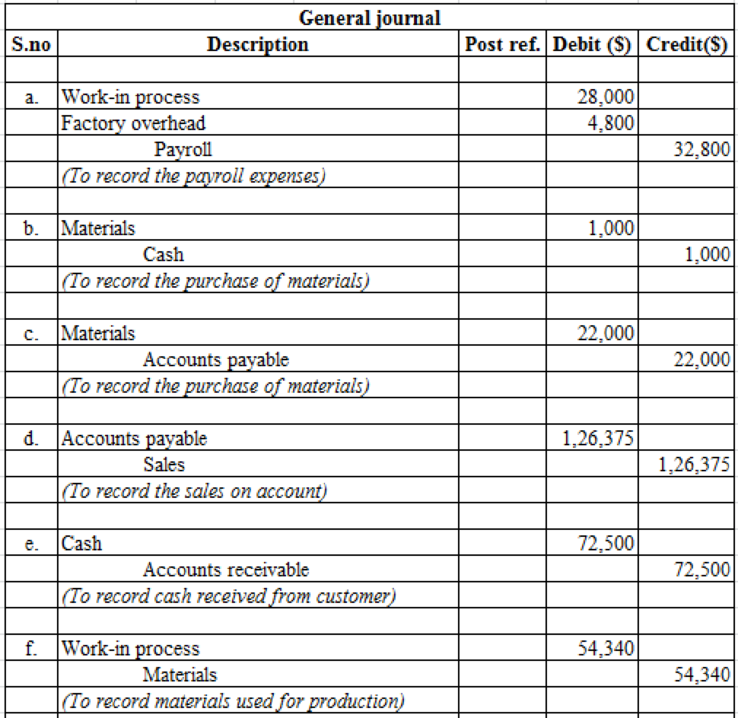
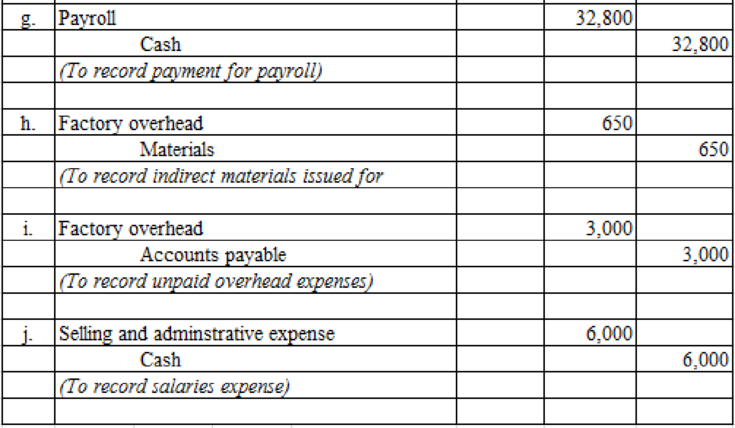
Table (21)
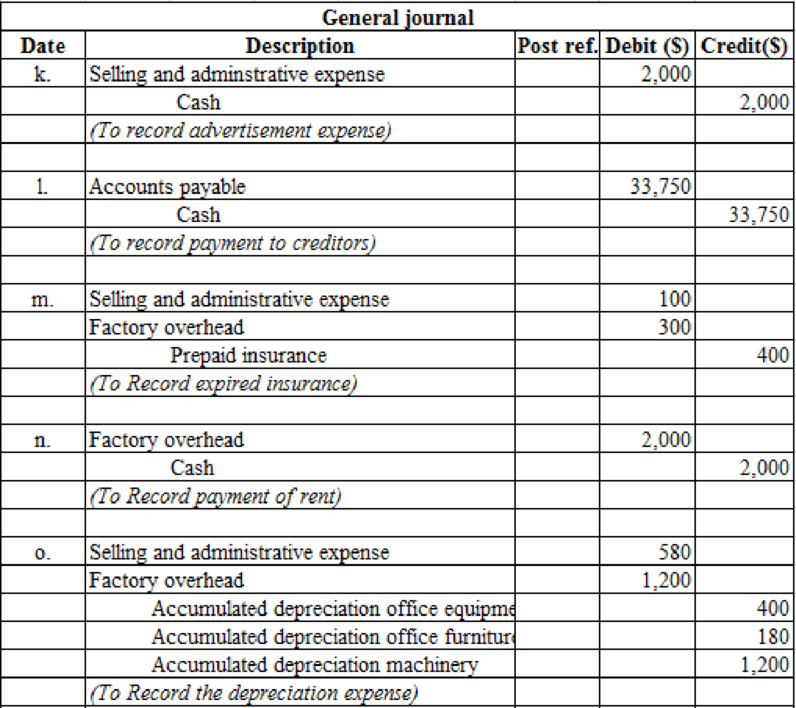
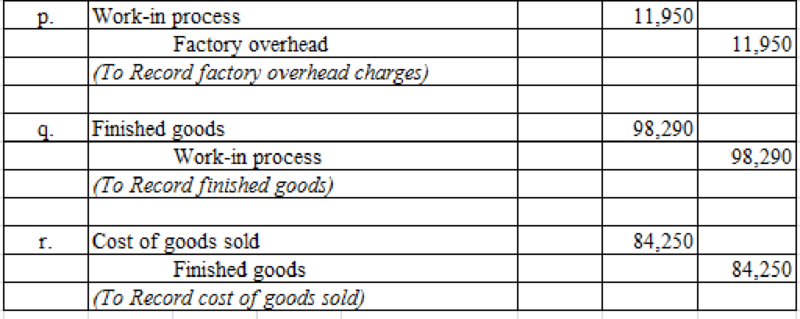
Table (22)
4.
Prepare the cost of goods manufactured statement.
Explanation of Solution
Cost of goods manufactured: The cost of goods manufactured is the total costs incurred for the manufacturing of a product which is transferred from work-in process inventory account to the finished goods inventory account.
Prepare the statement for cost of goods manufactured.
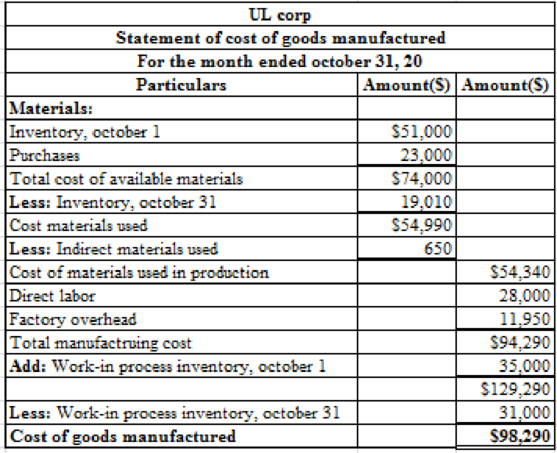
Table (23)
5.
Prepare an income statement.
Explanation of Solution
Income statement: The financial statement which reports revenues and expenses from business operations and the result of those operations as net income or net loss for a particular time period is referred to as income statement.
Prepare an income statement.
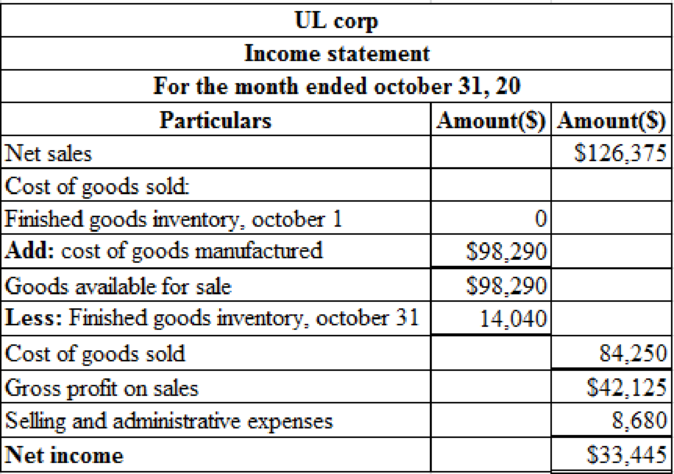
Table (24)
6.
Prepare the balance sheet.
Explanation of Solution
Prepare the balance sheet.
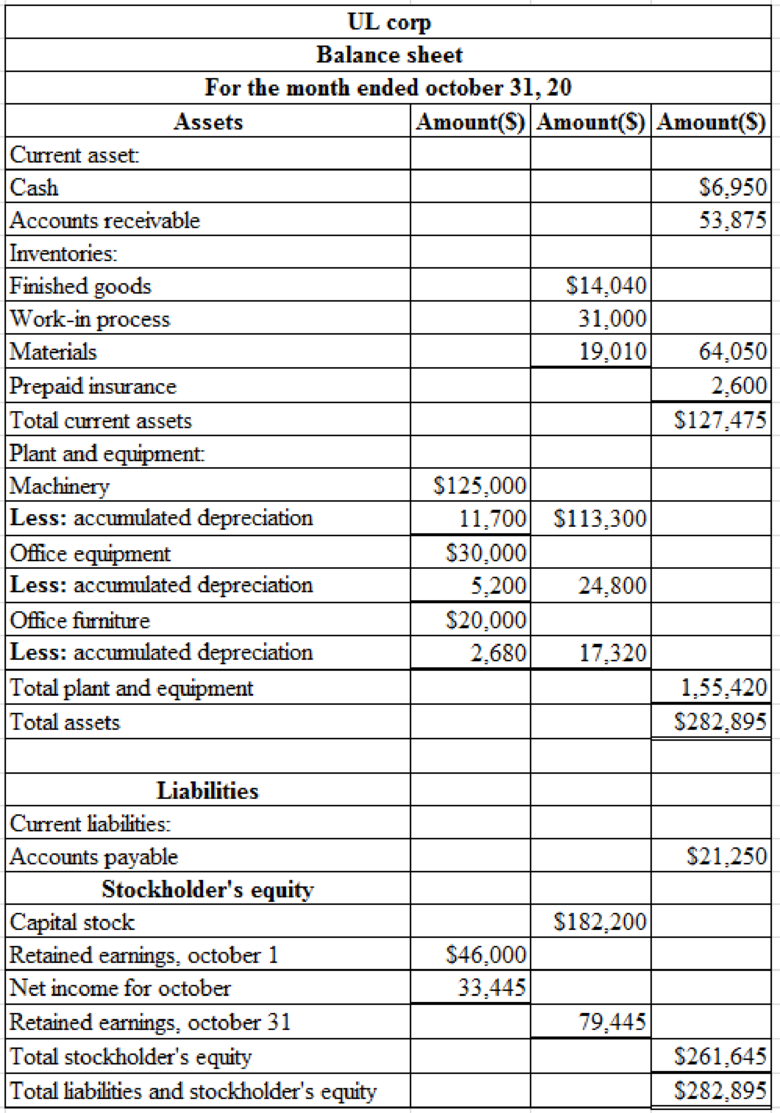
Table (25)
Want to see more full solutions like this?
Chapter 2 Solutions
Principles of Cost Accounting
 Principles of Cost AccountingAccountingISBN:9781305087408Author:Edward J. Vanderbeck, Maria R. MitchellPublisher:Cengage Learning
Principles of Cost AccountingAccountingISBN:9781305087408Author:Edward J. Vanderbeck, Maria R. MitchellPublisher:Cengage Learning Managerial Accounting: The Cornerstone of Busines...AccountingISBN:9781337115773Author:Maryanne M. Mowen, Don R. Hansen, Dan L. HeitgerPublisher:Cengage Learning
Managerial Accounting: The Cornerstone of Busines...AccountingISBN:9781337115773Author:Maryanne M. Mowen, Don R. Hansen, Dan L. HeitgerPublisher:Cengage Learning College Accounting, Chapters 1-27AccountingISBN:9781337794756Author:HEINTZ, James A.Publisher:Cengage Learning,
College Accounting, Chapters 1-27AccountingISBN:9781337794756Author:HEINTZ, James A.Publisher:Cengage Learning,


